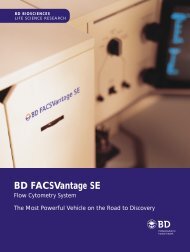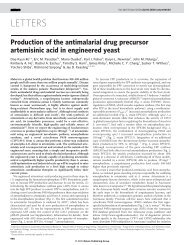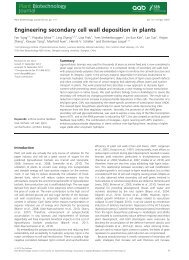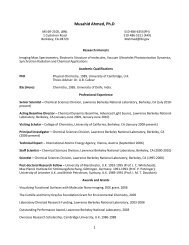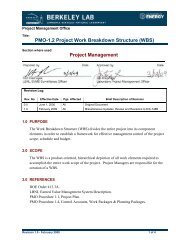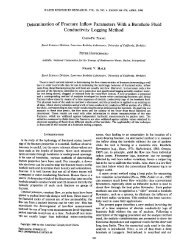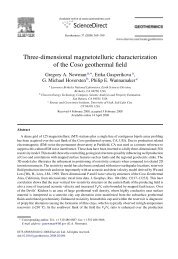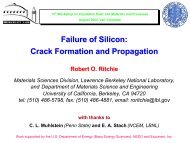LBNL Respiratory Protection Program - Lawrence Berkeley National ...
LBNL Respiratory Protection Program - Lawrence Berkeley National ...
LBNL Respiratory Protection Program - Lawrence Berkeley National ...
Create successful ePaper yourself
Turn your PDF publications into a flip-book with our unique Google optimized e-Paper software.
Advantages: The major advantage of this type of respirator is the positive pressure provided to<br />
the facepiece or hood. This type of respirator may be used during exposure assessment, when<br />
contaminant concentration is unknown but reasonably expected to be below IDLH concentrations.<br />
Limitations: These units are relatively expensive to purchase and maintain. The battery adds<br />
additional weight, and must be carried on the wearer's belt. The battery must be charged up prior to<br />
use. The filters and cartridges can bulky and awkward to wear. This class of respirator cannot be<br />
used in IDLH atmospheres or atmospheres deficient in oxygen. Heavy exertion may create<br />
negative pressure reducing the respirator's effectiveness.<br />
Applications: These units are useful for work that is more physically demanding; the air blown<br />
into the helmet, hood or tight fitting facepiece cools the wearer. Because some PAPR units are<br />
rated with an APF of 1,000, this respirator can be used when a high level of protection is required.<br />
Assigned <strong>Protection</strong> Factor: 1,000 (Tight-fitting full facepiece, Hood, or Helmet, with<br />
manufacturer documentation of performance); APF 25 when manufacturer documentation of<br />
performance is not provided; 25 (Loose-fitting facepiece); 50 (Half-facepiece);<br />
F. Airline Respirators (Continuous Flow or Pressure-Demand Mode)<br />
Description: An airline respirator provides fresh air to the wearer from a compressor or from<br />
compressed-air cylinders. The respirator may be a half mask, full facepiece, or loose-fitting<br />
facepiece (such as a helmet or hood). Breathing air must meet the requirements of Compressed<br />
Gas Association (CGA) Commodity Specification for Air, G-7.1-1989, Grade D. When oillubricated<br />
compressors are used to provide breathing air, the air is monitored with a carbon<br />
monoxide alarm set at 10 ppm. Breathing air couplings must be incompatible with outlets for<br />
nonrespirable worksite air (such as “shop air”) and other gas systems. Airline systems supplying<br />
atmosphere supplying respirators may only use Foster and Schrader brand fittings and couplings<br />
and these are Resticted Items and may only be purchased with approval of the Industrial Hygiene<br />
Group.<br />
Advantages: This class of respirator provides a high degree of protection against all varieties of<br />
air contaminants. Hood models may be worn by personnel with facial hair if required and<br />
necessary as outlined in <strong>LBNL</strong>'s <strong>Respiratory</strong> <strong>Protection</strong> Facial Hair Policy. Airline respirators<br />
operated in the continuous flow mode can be used in atmospheres that require supplied-air.<br />
Limitations: Air is delivered to the mask or hood through a breathing air hose. This hose can be<br />
awkward and heavy, and may become tangled and crimped. The length of the hose is limited to<br />
300 feet. Breathing air supplied by cylinders or by a compressor must be tested. Continuous flow<br />
use: the cost involved in equipping an air compressor can be prohibitive. Pressure-demand use: the<br />
air is supplied by a series of cylinders containing breathing air. The system must be maintained,<br />
and the MSA Hip-Air Pressure Demand Breathing Apparatus used at <strong>LBNL</strong> must be regularly<br />
tested and inspected.<br />
Applications: Continuous flow airline systems may be used by employees without further<br />
evaluation by Engineering Division Paint Shop employees for sandblasting and paint spray booth<br />
activities. Pressure-demand airline systems may be used by EHS Waste Operations for special<br />
processes, when the exposure has not been determined.<br />
<strong>LBNL</strong> <strong>Respiratory</strong> <strong>Protection</strong> <strong>Program</strong> Appendix G Selection of Respirators<br />
V2.4 Revised 3/28/12<br />
Page 4 of 5





